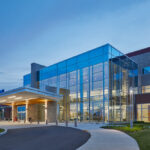NeoCon is accepting submissions for its Best of NeoCon competition, the show’s official awards program that recognizes exceptional new products from show exhibitors. Since its establishment in 1990, the program has been a beacon of innovation, garnering a diverse array of entries across various commercial sectors, including healthcare. The program will bestow Gold and Silver awards alongside honors in Innovation, Sustainability and Business Impact in 55 categories showcasing a comprehensive look at the diverse product offerings. Read More …
Registration Opens for 2024 ASHRAE Annual Conference
Registration is open for the 2024 ASHRAE Annual Conference taking place June 22-26 at the Marriott Indy Place in Indianapolis, Indiana. Early bird registration ends April 29. The conference will include activities such as tours, social events, award recognitions and a comprehensive technical program featuring more than 80 sessions. Read More …
BOMA Releases Newest Floor Measurement Standard for Office Buildings
The Building Owners and Managers Association International has released its latest floor measurement standard for office buildings, BOMA 2024 for Office Buildings – ANSI/BOMA Z65.1-2024. The standard includes many new features, enhancements and clarifications since the release of the 2017 edition. Read More …

Daytona Beach VA Clinic Earns Green Globe Certification
The U.S. Department of Veterans Affairs Daytona Beach VA Clinic in Florida has earned the achievement of the 2023 Green Globes Building Certification for New Construction: Two Green Globes Certified by the Green Building Initiative. The rating of Two Green Globes demonstrates significant achievement in resource efficiency, reducing environmental impacts and improving occupant wellness. Read More …

Leadership Changes Support Gensler’s Global Healthcare Practice
Bonny Slater, design director and senior associate and Randy Guillot, design director and principal, have been named co-global healthcare practice leaders at Gensler. Slater has more than 20 years of industry experience, with a background in interior design and environmental psychology. She brings a unique perspective and research-driven approach to both experience design and strategic planning, focusing on the connections between engagement, design and population health in vulnerable communities. Read More …

Jeanmarie Zimmerman Joins AE Works as Healthcare, Planning Strategy Leader
Jeanmarie Zimmerman, ACHA, AIA, EDAC, CCIDC, has joined AE Works’ Planning + Project Services group as healthcare and planning strategy leader. An American College of Healthcare Architects and Evidence Based Design Certified architect and interior designer, she Read More …

Tips for Scalable & Resilient Hospital Infrastructure
Using various scenarios to plan for a new, renovated or expanded facility — from business-as-usual operations to pandemics and natural disasters — hospital leaders and facility managers can shift their thinking from facilitating near-future operations to long-term financial and operational resiliency.
Simply incorporating the idea of resiliency into the planning vocabulary can expand the planning mindset to examine how well a facility and its mechanical, electrical and plumbing systems can absorb disruptions to normal operations.
In this sense, it allows a proper examination of flexibility; e.g., turning an ambulance bay into a chemical decontamination area; hiding gas lines and electrical outlets in support columns in an atrium to convert it into a temporary emergency treatment space or enabling air units in rooms to shift from positive to negative airflows. An example of resiliency consideration would be the capability of turning air handling units to 100% outside air.
During a recent hospital expansion consisting of a variety of different programs, these questions were considered. The project included adding approximately 200,000 square feet with four floors of patient space to the hospital. The decision was made to make two of the floors — the med/surge floors — have “pandemic mode” capability.
In this case, the control mode for the air delivery was defined as being 100% outside air and for all the patient rooms to be negative to support spaces in the interior. This was accomplished through direct digital controls and dampers. That was not the normal operation of the units, however. Keeping consumption in mind, running at 100% outside air leads to a significant cost increase, as opposed to running at code-required outside air.
It was determined that “normal mode” would be to have code-required outside air delivered from an energy recovery unit. The pandemic mode was built into the air handlers and ductwork distribution; the coils were sized to handle the increased volume of outside air and there were additional dampers and exhaust fans in the system to enable this mode of operation.
Scalability with flexibility
Thinking creatively about how spaces can be utilized beyond their normal state of operations is just one example of how planning can be more future-focused.
In a traditional master-planning phase, observed trends are often utilized to forecast a future that is predictable and achievable. The challenge for this traditional approach is that it assumes operations in a normal state, yet normal operations today are always on the edge of deviations in operations, whether from a pandemic, an active-shooter lockdown or a ransom-ware attack.
Understanding not only the operational scenarios, but also the growth plans and community needs, are key to right-sizing a facility for efficiency and future care delivery. Close coordination between the planners, architects and engineers ensures the design enables a future state of operations not limited by a “landlocked” program, whether interior spaces with no room for growth, or tight sites with no room to expand the footprint of a building.
From care spaces and patient rooms, to penthouse units, to IDF rooms with telephone closets that are four times bigger than historically sized, examining the complete operations of the hospital can help plan for scaling opportunities that mitigate future costs to accommodate changing care needs.
Consider an emergency department that treats more patients in mental health crises. Emergency rooms are neither appropriate nor therapeutic for treating patients who may be in a heightened state of distress. Through proper planning for flexibility and scaling, adapting spaces for emergency psychiatric assessment, observation and treatment could free traditional emergency resources for patients with physical needs, provide a proper therapeutic space for mental health treatment and even expedite a patient’s transition from emergency to outpatient care without large outlays of financial resources.
More than looking into a crystal ball, it’s about looking at resource allocation for future scenarios, such as caring for an aging population requiring more orthopedic care or planning for a baby boom. The money invested upfront for scalable and resilient operations with appropriate infrastructure could save significant money in future expansions.
Because today’s project costs frequently come in significantly higher than a typical owner’s budget, stakeholders might wish to consider installing only what is absolutely necessary for the needs of the first phase. Yet, to maximize resources, decisive planning would be mindful of what the space may become in order to minimize cost exposure, yet design the original components of a system to be able to scale up as the campus grows.
For example, a chiller plant can be designed with a pipe header that supports not only the two chillers being installed for current needs in phase one, but also another six chillers that may be called for over the project’s lifecycle. If the header is not sized correctly in the initial phase, it would be a tremendous task with tremendous cost to upsize it in the future.
A lifecycle approach
Owners often purchase equipment based on first cost due to budget constraints. Taking into consideration the operational cost of the equipment, service requirements and costs over its estimated life expectancy — also known as lifecycle costs analysis — is a much better approach on choosing the right equipment for the application.
This analysis should be further adjusted to consider technology changes. Planning for the long term means planning for change, especially to accommodate the infrastructure supporting not only the technology, but the systems driven by the technology. Not only the basics like fire alarm, nurse call and telephone systems, but now also cellular emergency communication systems, telemetry patient monitoring systems and digital imaging, and patient records, may rely on technology, as well as sensitive mechanical, electrical, plumbing and telecommunications systems — the essence of a “smart building.”
These systems are exponentially more sensitive, not just to keep the facility running, but also in a way that contributes to patient care. For example, lights may be dimmed or their color adjusted depending on time of day; fire alarm systems must be quieter in patient care areas; medical personnel in radiology, cath labs and surgery do not want to see lights flicker.
With perhaps millions of monitoring points for facilities staff to manage, and information flowing back to a central monitoring area that may not even be within the hospital, keeping up with technology means borrowing from the design principles of advanced data centers and telecom facilities. In particular, it’s crucial to ensure that critical power and building management systems are backed up via battery systems.
In today’s world, the new fact is that artificial intelligence is changing faster than most have predicted. Knowing where technology is going and how it will reshape the equipment used to deliver care is key to planning for the spaces to facilitate the new technology and equipment it powers.
Navigating through this fog of technology or equipment change has made the relationship with suppliers and manufacturers more vital. Bringing in trusted advisors with the design team can help facilitate designs that accommodate the evolution of equipment change and technology integration, rather than just hosting the equipment.
The adage that the only constant is change has never been truer, only today it is faster. By calculating the lifecycle costs appropriately with the right information, the design team can properly counsel owners and operators on choices that put hospitals on the right track for future flexibility and growth.

ERDMAN Welcomes Jim Medendorp as Healthcare Strategist
Jim Medendorp has joined ERDMAN as managing director of advisory services and a member of the senior leadership team. Notable for his ability to drive growth, enhance patient experiences and ensure regulatory compliance, his career is marked by a series of transformative achievements. His expertise encompasses strategic transformation, operational optimization and business development within the healthcare sector. Read More …
Upcoming Projects, March 2024
Visit MedicalConstructionData or contact them here for more information on these projects and thousands of other projects across the United States. MedicalConstructionData from BuildCentral gives you real-time access to projects and decision makers that matter to you. Read More …










